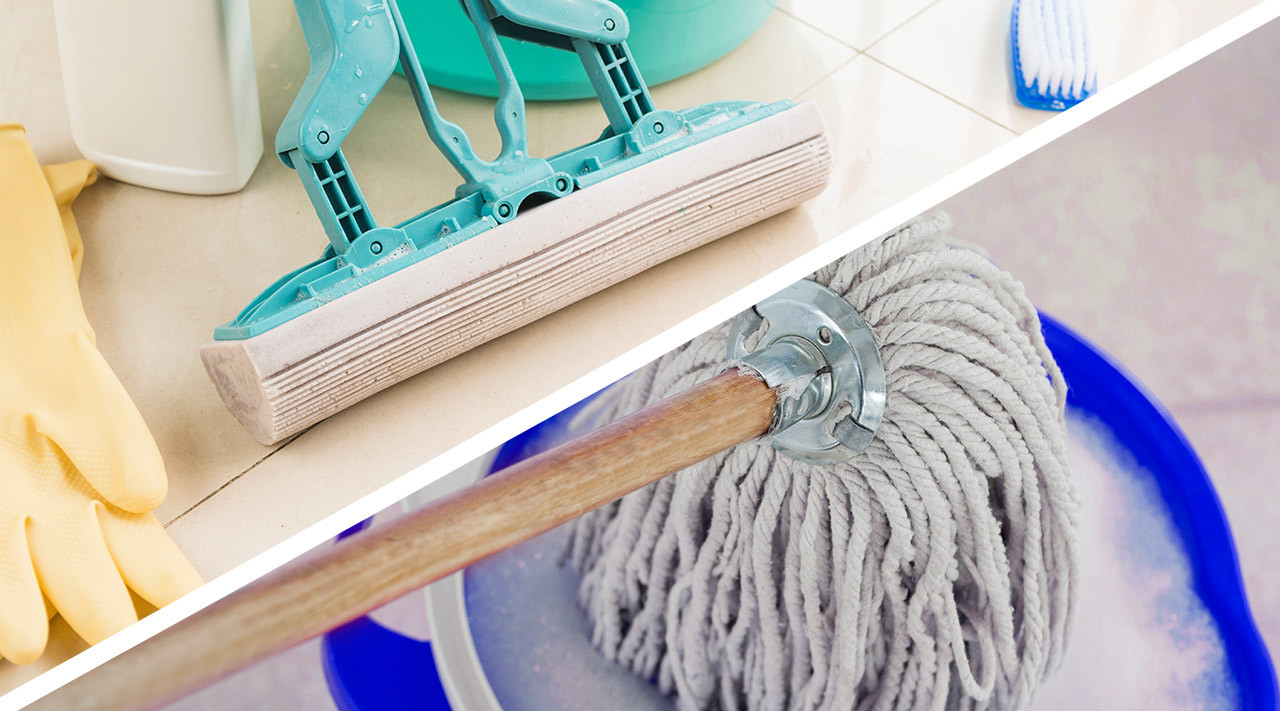Sponge Mop vs. String Mop: Which is Right for Your Facility?
When it comes to keeping floors clean, both sponge mops and string mops are trusted cleaning tools. But while they might look similar on the surface, they serve different cleaning needs. In this guide, we'll break down the key differences between sponge and string mops to help you choose the best one based on cleaning power, durability, cost, and use case, especially in commercial environments like gyms, schools, and restrooms.
Cleaning Power: Which Mop Handles Messes Best?
Sponge mops are highly absorbent and perfect for quick clean-ups on smooth, delicate floors like hardwood, laminate, and tile. Their textured sponge heads are great for picking up sticky spills or light daily grime. However, they may struggle with deep cleaning tasks or uneven surfaces.
String mops, also known as traditional mops, are ideal for heavy-duty cleaning. With longer strands made from cotton or microfiber, they’re better suited for soaking up large spills, scrubbing textured floors, and cleaning high-traffic areas where grease and grime accumulate—think gyms, cafeterias, and industrial settings.
Understanding the cleaning process is crucial in selecting the right mop for your needs. Different mops come with various types of mop heads, such as microfiber and cotton, which can be replaced and machine-washed for convenience.
Quick Take: Use sponge mops for surface-level cleaning and string mops for deep-cleaning and durability.
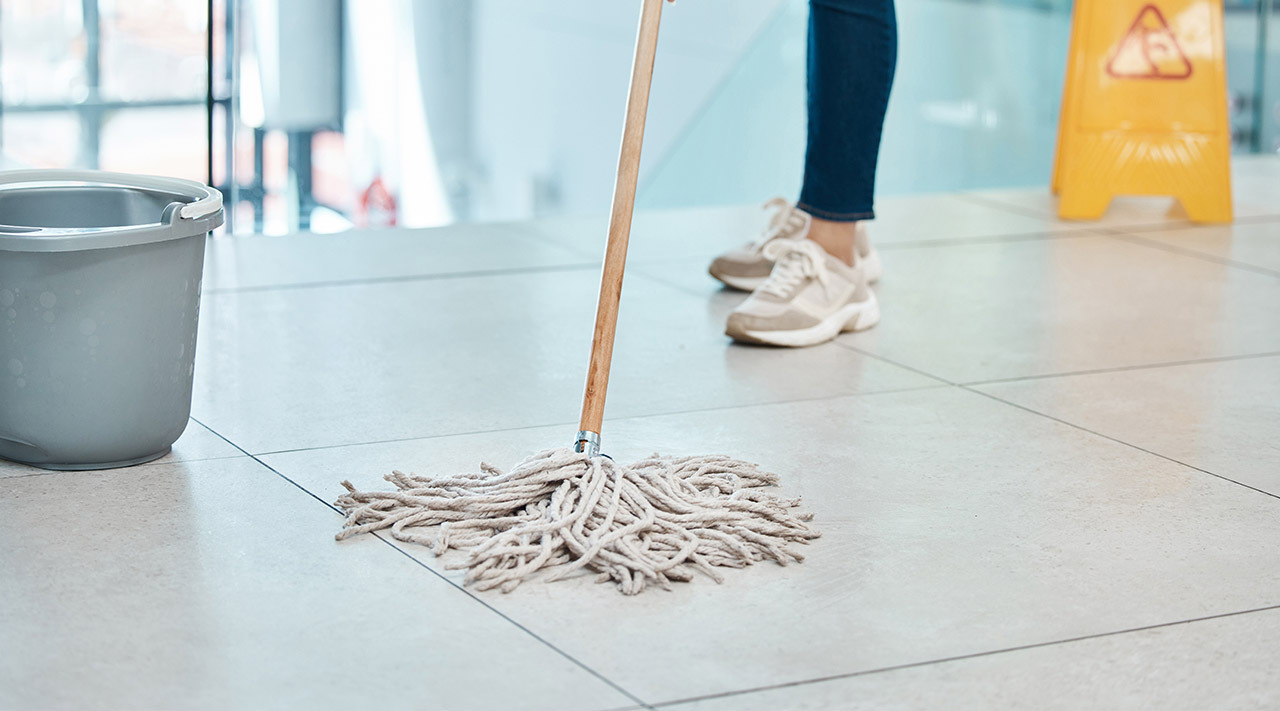
Maintenance & Durability: Which Mop Lasts Longer?
Sponge mops require more attentive care. However, be cautious of excessive moisture when using sponge mops on wood floors, as it can cause damage. The sponge head must be rinsed thoroughly and allowed to dry completely after each use to prevent odor and bacteria growth. Their textured sponge heads are great for trapping dirt and sticky spills. If not cleaned properly, sponge heads can degrade quickly.
String mops tend to be more durable. String mops are ideal for achieving a thorough clean in high-traffic areas. Especially the looped-end mop head versions, which can withstand multiple wash cycles and resist fraying. Cotton and microfiber versions are often machine washable, making them easier to sanitize regularly.
Pro Tip: Looped-end string mops last longer than cut-end versions and are more economical over time.
Cost & Refill Needs
Sponge mops are typically affordable, but their heads may need replacing more frequently, especially with heavy use. Proper maintenance is crucial to prevent odor and bacterial growth in sponge mops. They’re best suited for environments where lighter maintenance is performed more often.
String mops may have a higher upfront cost, particularly for commercial-grade options, but they usually last longer. Cotton and microfiber versions are often machine washed, making them easier to sanitize regularly. Replacement heads cost less per use over time, and drying is quicker with microfiber variants.
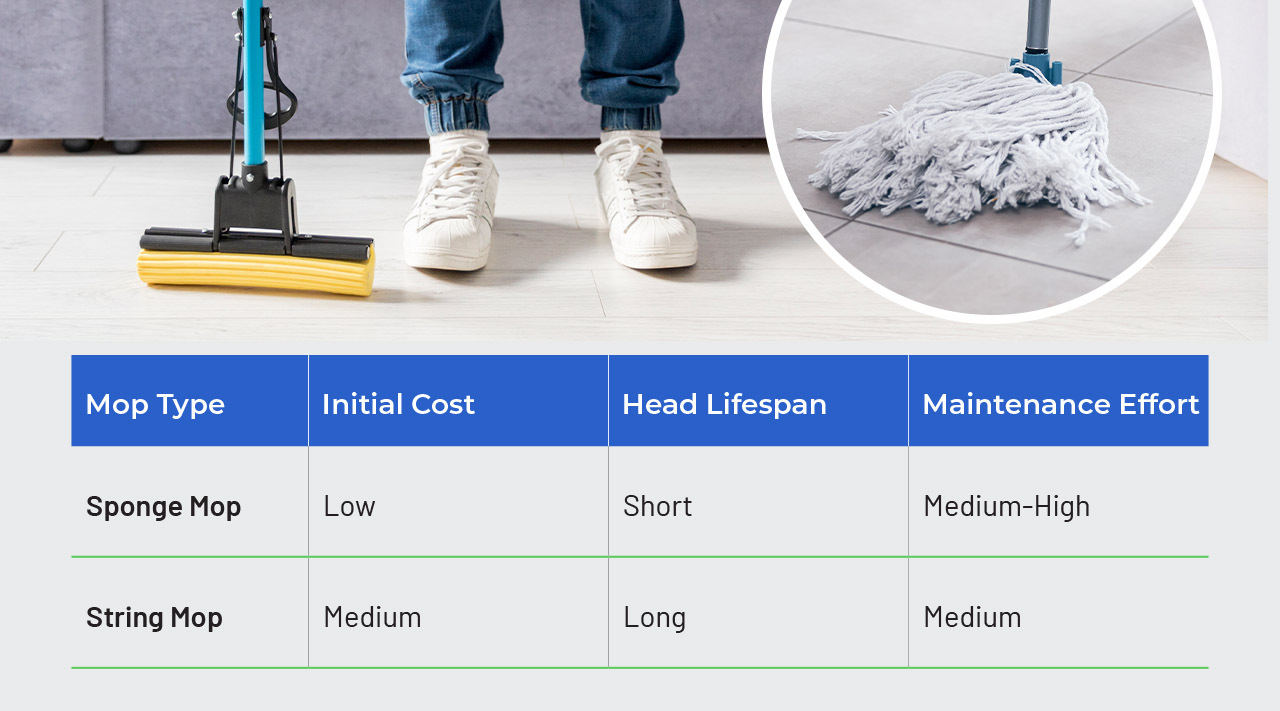
Best Use Cases: Where Each Mop Works Best
Choosing the right mop depends largely on your environment:
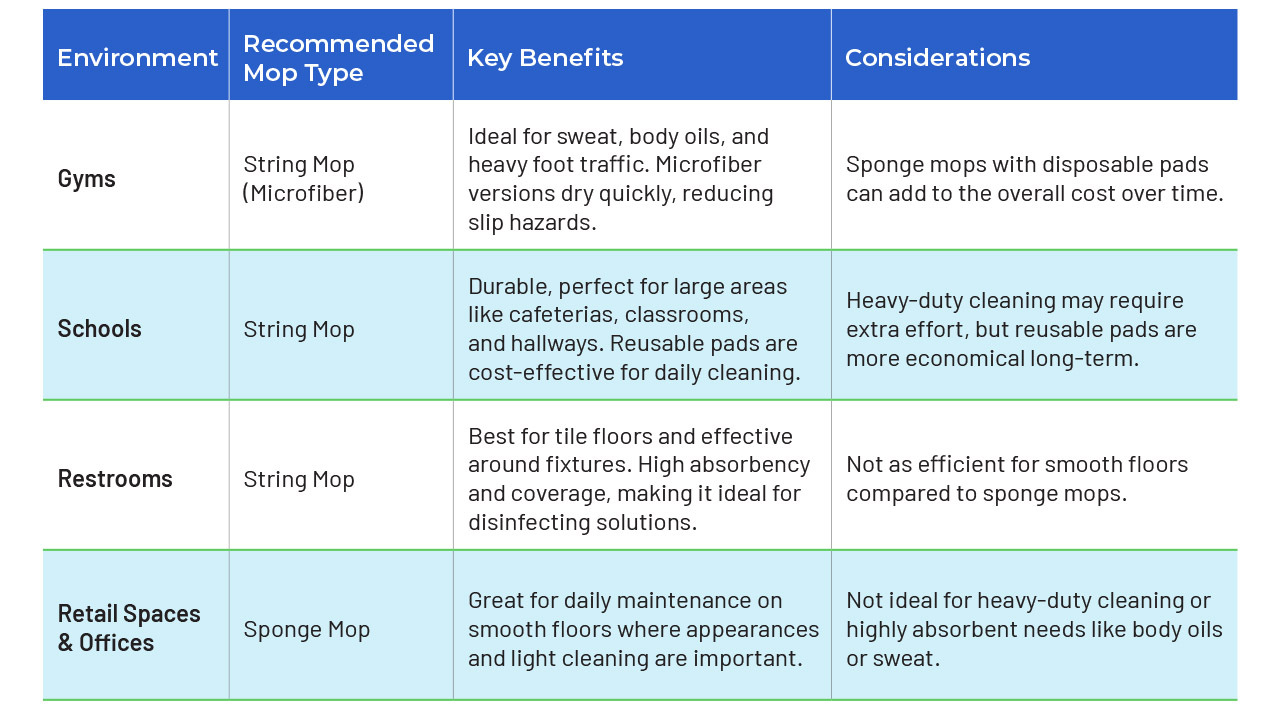
Need help understanding mop types? Read our guide on Types of Mops →
Choosing the Best Mop for Your Facility
If you need a lightweight, user-friendly tool for quick cleanups and smooth floors, a sponge mop is a solid choice. Sponge mops are suitable for various surfaces, including smooth floors and walls. But if your facility demands deep cleaning, heavy spill absorption, and resilience, especially in large or high-traffic areas, a string mop is the more powerful and cost-effective option. String mops are also effective in tight spaces, such as around fixtures in restrooms.
Still not sure? Match your mop to your environment for the best results. Having a diverse cleaning arsenal ensures you have the right tool for every cleaning task.
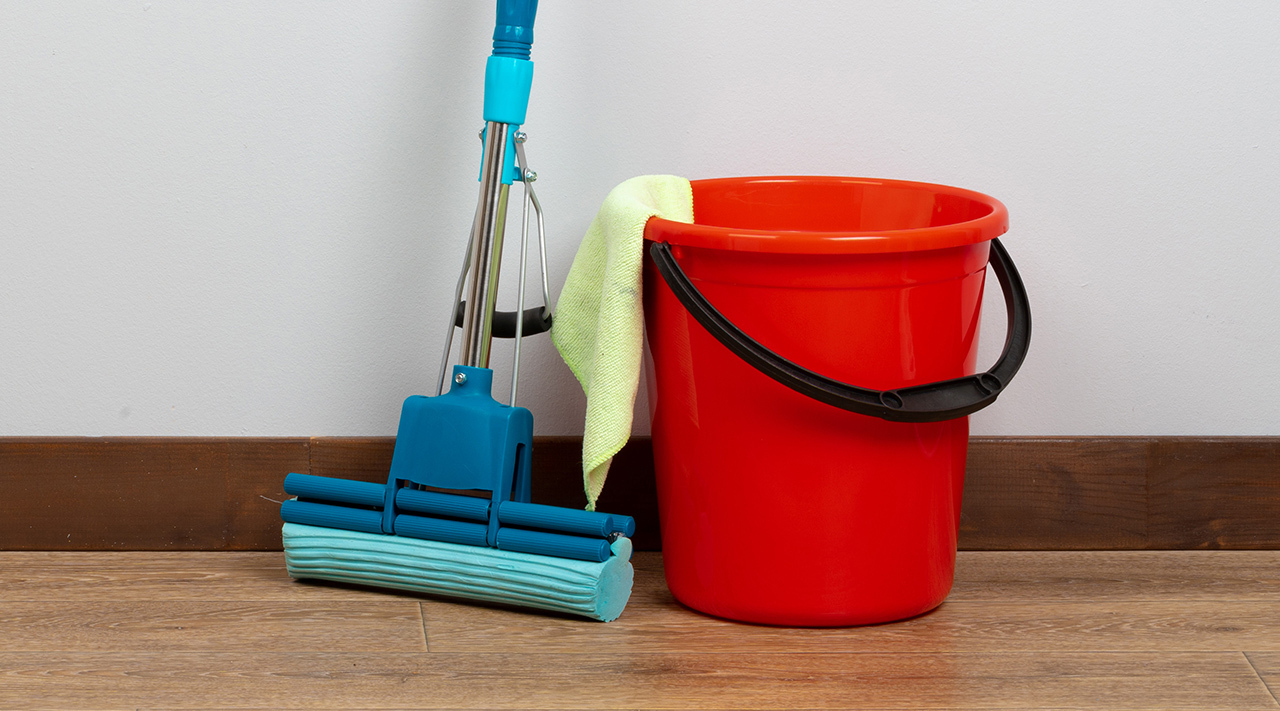
Shop Our Recommended Mops
Discover our curated selection of commercial-grade sponge and string mops designed for performance, durability, and ease of use. Our selection includes a variety of cleaning supplies to meet your specific needs.
Frequently Asked Questions (FAQs)
Which mop is better for quick daily cleanups?
Sponge mops are lightweight, highly absorbent, and easy to maneuver, making them ideal for fast, everyday floor maintenance.
What kind of mop works best for large, high-traffic areas?
String mops are more durable and better suited for large surface areas and deep cleaning—perfect for gyms, cafeterias, and industrial spaces.
Are sponge mops safe for hardwood floors?
Yes, sponge mops leave behind minimal moisture and are gentle on delicate surfaces like hardwood and laminate, making them a safe choice.
How often should mop heads be replaced?
Sponge mop heads typically need replacing every 1–2 months with frequent use, while looped-end string mop heads last several months depending on maintenance.
Can string mops be washed?
Yes. Many string mops—especially microfiber or cotton looped-end types—are machine washable, making them easy to sanitize and reuse.
Do I need a special bucket for string mops?
Using a mop bucket with a built-in wringer is recommended for string mops to remove excess water and ensure proper sanitation.
Which is better, sponge mop or string mop?
It depends on your cleaning needs. Sponge mops are better for quick cleanups on smooth, delicate surfaces like hardwood or tile. String mops are better for large, high-traffic areas and heavy-duty cleaning thanks to their superior absorbency and scrubbing power.
What are the disadvantages of a sponge mop?
Sponge mops can be harder to wring out completely and require thorough cleaning to prevent bacteria and odor buildup. They’re also less effective on uneven surfaces and aren’t ideal for deep cleaning tasks.
Which type of mop is most effective?
String mops are the most effective for large-scale, high-traffic, or heavy-duty cleaning jobs. Their absorbent, flexible strands can cover more area and tackle tough messes better than most other mop types.
What is the best method of mopping?
Start by vacuuming or sweeping the area. Use a figure-eight or “S” pattern while mopping to avoid redistributing dirt. Wring your mop frequently and change water as needed. Always let the floor dry completely to prevent slips or water damage.
Recent Posts
-
Fragrance-Free vs Scented: Build an Allergy-Safe Cleaning Program that Still Works
When "Clean" Becomes a Complaint You know the scene: your custodial team disinfects the office overn …Dec 05, 2025 -
How to Prevent Slippery Floors After Disinfecting: Custodian Safety Guide
When Clean Turns Dangerous You've just finished disinfecting the lobby floor. It's spotless. Germ-fr …Nov 28, 2025 -
Sensitive Skin Cleaning: Low Irritant Disinfectants, Gloves, and Hand Care Stations
Facility managers often report that skin irritation ranks among the top three health complaints from …Nov 14, 2025

